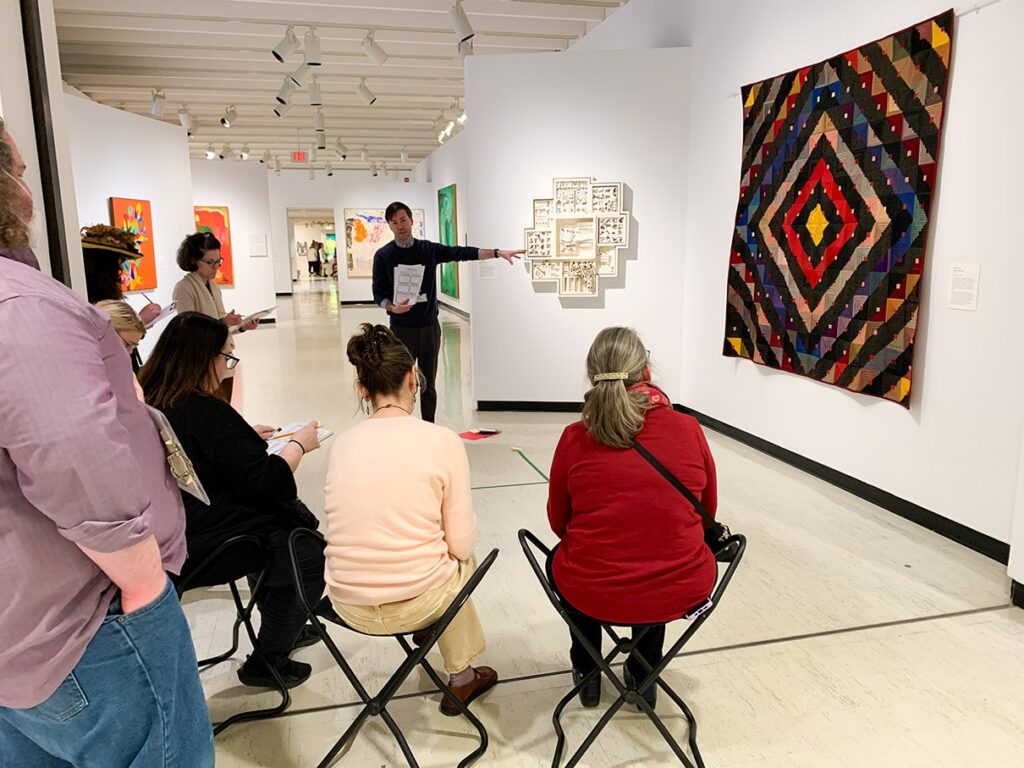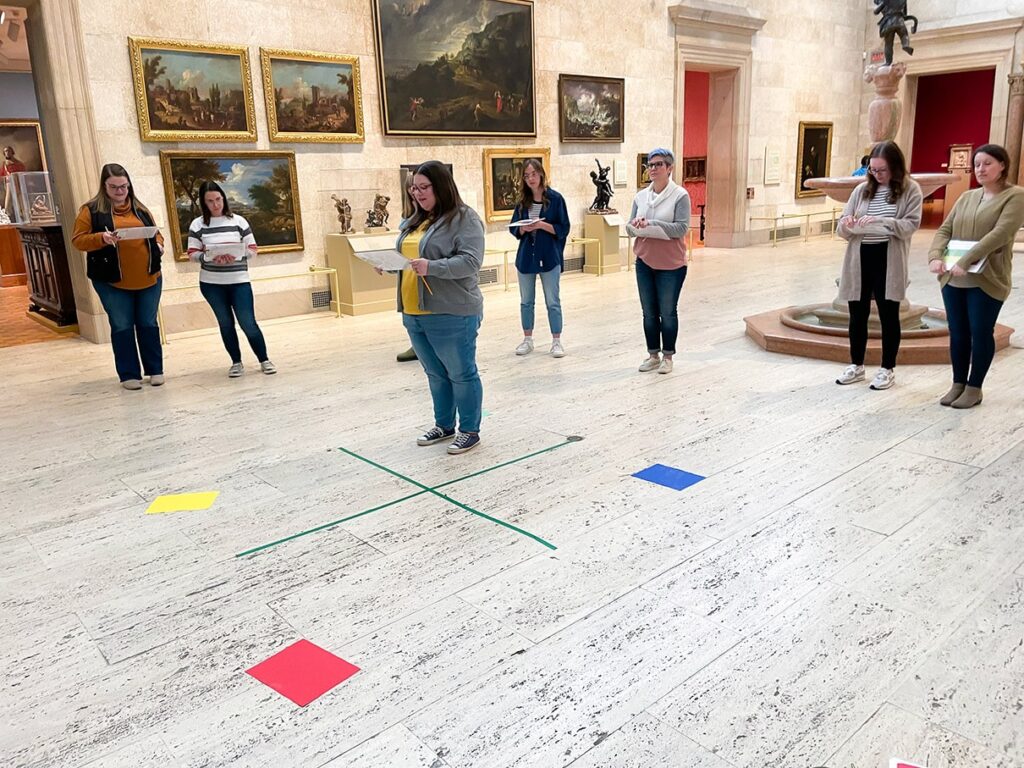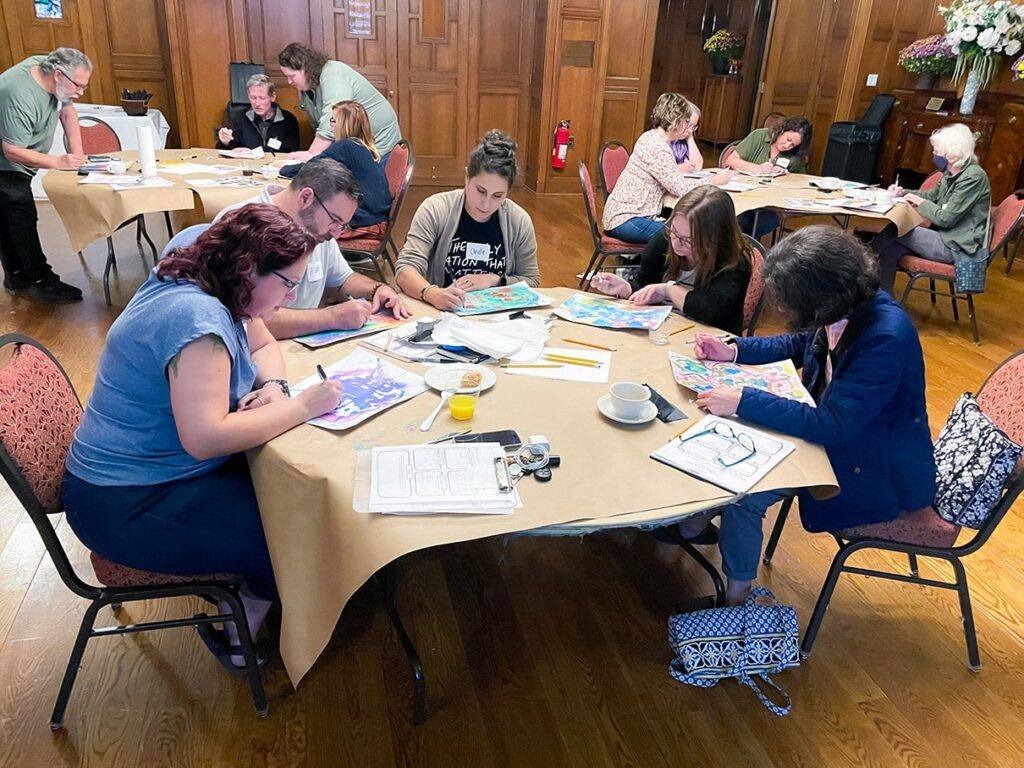We are dedicated to supporting PreK–12 teachers with integrating art into their curriculum and growing as professionals. Contact us to discuss how to use art in the classroom, to collaborate on developing a workshop or planning a teacher-guided tour, and to learn about resources available online or to check out from our library.
Contact
learning@mag.rochester.edu
585.276.8973
Especially for Educators
Especially for Educators is MAG’s series of professional development workshops designed for PreK–12 teachers of all subjects in public, charter, and independent schools as well as educators in homeschools, informal, or non-traditional learning spaces.
Workshops are open to and free for all educators. Registration is required.
All participants can receive Continuing Teacher and Leader Education (CTLE) credit hours.
In addition to highlighting art in our permanent collection and temporary exhibitions, workshops include:
- presentations from curators and guest speakers
- gallery activities facilitated by museum educators
- art-making guided by teaching artists
- light refreshments
Educator Toolbox
We create items using input from educators on our Teacher Advisory Council and based on participant feedback from professional development workshops.
These resources aim to:
- be easily adaptable to your curriculum
- support arts integration across grade levels and content areas
- complement school tours or visits from MAG’s museum educators
If you would like support in implementing these tools, are looking for a resource you used in the past, or have ideas for new ones to be developed, please reach out to learning@mag.rochester.edu!
Artful Thinking Routines
Artful Thinking Routines, designed by Project Zero at Harvard University, develop students’ critical thinking through the use of simple activities that guide them in responding to art. Visual art can be a springboard for developing thinking skills and habits that students can then apply across the curriculum. Artful Thinking Routines support several thinking dispositions – Questioning and Investigating, Observing and Describing, Comparing and Connecting, Finding Complexity, Exploring Viewpoints, and Reasoning.
We provide four graphic organizers, which can be used with any work of art, with unique prompts and questions that target specific thinking dispositions. The graphic organizers can be downloaded in PDF form at the link above and are useful in making students’ thinking visible to themselves, to peers, and to teachers. If students are still developing their writing skills, the worksheets can be adapted as a verbal activity or with student responses scribed by a teacher. The prompts and questions for each routine are included below.
Looking 5 x 2
Thinking dispositions this supports: Observing and Describing
- Look at the artwork for a full minute.
- On your own, list five descriptive words or phrases about any aspect of the artwork.
- Share something from your list with a partner or the group.
- Repeat steps 1 and 2. Try to add five new descriptive words or phrases to your list.
- Share a new observation with a partner or the group.
Creative Questions
Thinking dispositions this supports: Questioning and Investigating
- Brainstorm open-ended questions about the artwork using the questions stems provided or your own.
- Put a star next to the question you think would be most interesting to discuss.
- Share your question with a partner or the group.
3 Details/3 Feelings
Thinking dispositions this supports: Exploring Viewpoints, Reasoning
- Name one feeling this artwork suggests for you.
- What are three details you see that evoke this feeling?
- Choose a new detail that stands out to you to focus on.
- What are three feelings that detail could evoke?
- Now try on someone else’s feeling (from a partner or the group) – a feeling that wasn’t an initial response for you. Look at the work of art again through that lens – what is your experience viewing this work through someone else’s emotional response?
3-2-1 Bridge
Thinking dispositions this supports: Observing and Describing, Questioning and Investigating, Comparing and Connecting
- How might you see yourself reflected in this artwork? How might this artwork be a bridge to you, your feelings, and/or your experiences?
- What are three observations or things you notice about this artwork?
- What are two questions that come to mind about this artwork?
- If this artwork (or part of it) were a metaphor for something, what might it represent?
Social-Emotional Learning Check-Ins
Social Emotional Learning check-ins provide a visual way for students to share how they are feeling. Each check-in includes six thematic artworks from MAG’s permanent collection. Here are a few simple ideas of ways to incorporate them into your classroom!
Steps for using the check-ins:
- Display the check-in on the board or provide physical copies for students to reference.
- Provide a check-in prompt. For example: Which artwork represents how you are feeling…
- at the start of today’s lesson?
- after group work?
- about this new topic?
- at the end of this unit?
- about an upcoming event (concert, teacher transition, conferences, test)?
- during independent work time? -at this point in the school year?
- Encourage students to share their choice and reasoning…
- with a partner
- in a small group
- with the whole class
- in writing
Other ideas for using the check ins:
- record choices and graph trends (Math)
- connect artworks to emotions of characters or plot events (ELA)
- connect artworks to emotions of historical figures or significant events (Social Studies)
Current themes:
- Sculpture Park (2)
- Abstract Art
- Action (2)
- Animals
- Alma Thomas (2)
- Black Artists
- Bridges
- Female Artists
- Nature
- People (3)
- Places
- Sculpture (2)
Archaeology Alive!
Files available:
- Digging Down demo excavation video notes
- Archaeology Alive! widescreen format slideshow
- Archaeology Alive! standard format slideshow
- Archaeology Alive! slideshow script
- Harris Matrix activity sheet
MAG’s Archaeology Alive! classroom materials can help you and your students in grades 6–12 explore the science of archaeology, learn about the origins of some of MAG’s ancient artifacts, and have a hands-on experience with some authentic artifacts. These resources were developed and tested in Rochester area schools by MAG Academic Programs staff and archaeologist Dr. Alexander Smith.
ABOUT DR. ALEXANDER SMITH
A 2015 Ph.D. graduate from Brown University’s Joukowsky Institute for Archaeology and the Ancient World, Dr. Alexander Smith is a Rochester native. Fieldwork has taken him to locations including Rome, Sardinia, Jordan, Guatemala, and Montserrat, but he specializes in Mediterranean archaeology and the computerized techniques of surveying and mapping archaeological sites. His work at Brown University also included extensive classroom outreach to Providence, RI area schools.
What is Archaeology? An Introduction
A slideshow (standard format or widescreen) with accompanying informative script, initially developed by Dr. Alexander Smith, introduces the tools, terminology, and techniques used by modern archaeologists. See images of actual fieldwork and finds, and get answers to crucial questions such as, “How do archaeologists know where to dig?” “Why is sifting important?” “What are the five ancient-world metals?” and “Do archaeologists study dinosaurs?” Feel free to adapt the accompanying script information for your students’ needs.
Digging Down: A Virtual Archaeological Excavation
Stratigraphy, or “layers in the dirt,” forms the basis for archaeological exploration, excavation, and dating of finds. Watch as archaeologist Dr. Alexander Smith reenacts the principles of stratigraphy by conducting a simulated excavation using simple blankets and a plastic bin. This video is a great addition to the introductory slideshow described above. We also offer a student notes sheet to accompany the video.
The Harris Matrix: The Logic of Archaeological layers
For more advanced students, introduce a mathematical-logic element to your archaeological explorations by trying your hand at creating a Harris Matrix. This is a tool resembling a flow chart, grounded in the three basic laws of archaeological stratigraphy, and used by archaeologists to diagram and record the layers of soil and human occupation at an excavation site. This is a great follow-on activity for Digging Down: A Virtual Archaeological Excavation, described above.
Archaeology Alive! The Hands-on Artifact Activity
This culminating activity, facilitated in your classroom by a MAG Museum Educator, uses a selection of small, authentic objects from MAG’s collection of teaching objects. The activity offers your students a hands-on encounter with the ancient world, inspires their observation and critical thinking skills, and enhances the learning connections made through the introductory slideshow and the virtual excavation. This option is available only as a supplement to a scheduled class field trip to MAG; our popular tour of ancient cultures, Passport to the Past, is a great fit.
Contact learning@mag.rochester.edu to discuss scheduling The Artifacts Kit experience for your class.
Custom Workshops
Interested in scheduling a personalized workshop for your school or district? We can work with you to plan and execute a workshop aligned to your professional development goals and priorities!
Please complete our Custom Workshop Request Form or contact us at learning@mag.rochester.edu for more information.
Experiences & Pricing
Short (1–2 hours)
Includes: 1 facilitated experience in galleries + discussion/debrief
| $100 | 5–10 participants |
| $150 +$10 per person above 15 | 11–20 participants |
| $250 +$10 per person above 25 | 21–30 participants |

Medium (2.5–3.5 hours)
Includes: 2 facilitated experiences in galleries + time for self-guided exploration + discussion/debrief
| $150 | 5–10 participants |
| $225 +$10 per person above 15 | 11–20 participants |
| $375 +$10 per person above 25 | 21–30 participants |

Long (4–5 hours)
Includes: 2 facilitated experiences in galleries + time for self-guided exploration + discussion/debrief + art-making with a teaching artist
| $225 | 5–10 participants |
| $300 +$10 per person above 15 | 11–20 participants |
| $450 +$10 per person above 25 | 21–30 participants |

Why take a workshop with us?
This was the best workshop I have ever attended in 15 years as an educator. It was so fun and insightful.
Workshop Participant
Very interactive!!! I really loved how we had the opportunity to walk through the process of discussing art together because it showed me how I can do this with my own students. I also really enjoyed the art creation activity!
Workshop Participant
Participants rate our workshops as:
93%
exceeding expectations
100%
engaging & providing skills
that will improve teaching


Participants rate themselves as likely to:
98%
attend future offerings
95%
implement learning from
the workshop in their classroom
The Memorial Art Gallery’s School Programs are sponsored by Louis Valinoti, an anonymous foundation, and ESL Charitable Foundation, with additional support from an anonymous donor, Peter J. Papadakos, and Jane Colangelo. Funding is also provided by New York State Council on the Arts with the support of the Office of the Governor and the New York State Legislature.
Additional support for School Programs is provided by the John C. and Elsa L. Beach and Eileen M. Sullivan Education Endowment, the Elizabeth Brayer Family Endowment, the Elizabeth L. and Donald M. Cohn Endowment Fund, the Docent Endowment Fund, the Emma Jane Drury Education Fund, the MAG Education Endowment Fund, the Patricia S. Fishman Educational Endowment, the Joanna M. and Michael R. Grosodonia Fund, the Frank Grosso and Diane Holahan Grosso Fund, the Mary Sue Jack Endowed Fund, the Marion Lord and John L. Swierkos Education Endowment, the Memorial Art Gallery Community Access Endowment, the Powers Family Endowment, the Mary Ann Monley and William D. Rice Education Endowment, and the Josephine Tota Endowment.
The McPherson Director of Academic Programs is partially endowed by an anonymous donor and supported by the MAG Director of Education Fund and the Joan Feinbloom School Programming Fund. Support for the Estelle B. Goldman Museum Educators is provided by the Estate of Estelle B. Goldman.



